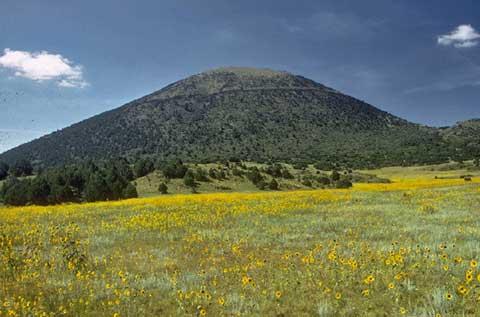This 1,000-foot-high cinder cone was formed after earthquakes and fireworks-like explosions hurled molten rock thousands of feet into the air. Nope, it's not in Hawaii, and this mount is not named for a saint.
Volcanic activity at Capulin Volcano National Monument last occurred many thousands of years ago, and today you can drive a 2-mile paved road to the top of the huge cinder cone, where paved trails into the crater and around its rim allow you to explore the extinct volcano.
The impressive geologic forces that formed Capulin Volcano occurred long before politicians roamed the earth—or before the area was called New Mexico. Capulin Mountain National Monument was originally established on August 9, 1916, after the area was "withdrawn" from other uses way back in 1891. That makes the site a few weeks older than the National Park Service itself.
On December 31, 1987, Congress changed the site's name from Capulin Mountain to Capulin Volcano to more accurately reflect the nature of the area. Whatever it's officially labeled, the view from the top is impressive. It's been said that view includes parts of five states, a claim which prompted a bit of clever clarification on the park's website:
From the highest point on the crater rim trail on a clear day, visitors can see formations in Colorado, New Mexico, and Oklahoma. Some claim to see Kansas, but since there are no high points in western Kansas, it's hard to tell. The last formation in New Mexico to the east, Rabbit Ear Mountain, is visible on clear days and anything beyond it is Texas.
To fully appreciate this dramatic landscape, you need to get out of your car, and you have a choice of five trails, ranging from easy to strenuous.
If you don't want to drive to the summit, three of the trails are located at the base of the cone.
The Nature Trail is adjacent to the Visitor Center, near the base of the volcano. It's a figure eight sidewalk trail that is handicapped-accessible. The Lava Flow Trail at the base of the volcano is an unimproved, one-mile loop that crosses one of the volcano's lava flows.
For a more challenging hike, the Boca Trail offers an unimproved two-mile loop through the vent area from which the volcano's lava flows originated. This trail is described by the park staff as "strenuous," and it provides close-up views of numerous geologic features. Pick up a self-guiding trail brochure at the visitor center before you start your trek.
If you drive to the top of the cone, there are two additional options for hikes. Keep in mind that the elevation at the highest point on the peak is 8,182 feet, so the air can seem a bit thin for flatlanders. This isn't Kansas anymore…even if you might be able to see it from the summit.
The Crater Vent Trail is paved, has an elevation change of 100 feet, and covers 0.4 miles round-trip. The Crater Rim Trail is a paved, one-mile loop, and is described as "moderately difficult due to steep climbs and descents." Wayside exhibits with panoramic photographs provide information about the volcano field.
The Visitor Center contains exhibits about the geology, natural history and human history of Capulin Volcano. A ten-minute video details the story of Capulin's eruption and the surrounding Raton-Clayton Volcanic Field.
Capulin Volcano is in northern New Mexico, 33 miles east of Interstate 25 at Raton, NM. The park website includes driving directions, park maps and information on operating hours. Check the web site for important details if you're towing a trailer, and for tips on meals or lodging in the area. One of the appeals of the park is the wide-open-spaces scenery, which means places to eat and sleep in the vicinity are available but not abundant. A little advance planning can cut down on the "are we there yet?" wails when it's mealtime.
Inspector W.D. Harlan of the General Land Office visited the area in 1890, and in a report to his Washington headquarters stated that "Prof. Dana of Yale College, who is regarded as the best authority in this country on Volcanoes says that 'Capulin is the most perfect specimen of extinct volcanoes in North America'."
"Prof. Dana" knew his stuff, and while this small park may be a bit off the beaten path, it's worth a stop—or a short side-trip off I-25—if you're in the area.




Add comment